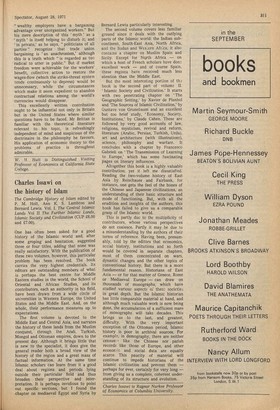Charles Issawi on the history of Islam
The Cambridge History of Islam edited by P. M. Holt, Ann K. S. Lambton and Bernard Lewis. Vol. I. The Central Islamic Lands Vol II The Further Islamic Lands, Islamic Society and Civilization (CUP £6.00 and £7.00).
One has often been asked for a good history of the Islamic world and, after some groping and hesitation, suggested three or four titles, adding that none was really satisfactory. With the publication of these two volumes, however, this particular problem has been resolved. The book carries the very highest credentials. Its editors are outstanding members of what is perhaps the best centre for Middle Eastern studies in the world, the School of Oriental and African Studies, and its contributors, each an authority in his field, have been drawn from a wide circle of universities in Western Europe, the United States and the Middle East. And, on the whole, their performance measures up to expectations.
The first volume is devoted to the Middle East and Central Asia, and narrates the history of these lands from the Muslim conquest, through the Arab, Turkish, Mongol and Ottoman empires, down to the present day. Although it brings little that is new to the specialist, it does give the general reader both a broad view of the history of the region and a great mass of factual information. At the same time Islamic scholars can learn from it a good deal about regions and periods lying outside their particular field and thus broaden their perspective and interpretation. It is perhaps invidious to point out specific sections, but I found the chapter on mediaeval Egypt and Syria by Bernard Lewis particularly interesting.
The second volume covers less familiar ground since it deals with the outlying parts of the Islamic world: the Indian subcontinent, South-East Asia, North Africa, and the Sudan and Wes:ern Aft:ea; it also contains a chapter on Muslim Spain and Sicily. Except for North Africa — on which a host of French scholars have don2. excellent work — and of course Spain, these regions have received much less atention than the Middle East.
But the most interesting portion of thz.• book is the second part of volume IL 'Islamic Society and Civilization.' It starts with two penetrating chapter on 'The Geographic Setting,' by Xavier de Planhol and 'The Sources of Islamic Civilization,' by Gustave von Grunebaum and an excellent but too brief study, 'Economy, Society, Institutions,' by Claude Cahen. These are followed by very good accounts of law, religions, mysticism, revival and reform, literature (Arabic, Persian, Turkish, Urdu), art and architecture (with illustrations), science, philosophy and warfare. It concludes with a chapter by Francesco Gabrieli on 'The Transmission of Learning to Europe,' which has some fascinating pages on literary influences.
Altogether this book is a highly valuable contribution; yet it left me dissatisfied. Reading the two-volume history of East Asia by Reischauer and Fairbank, for instance, one gets the feel of the bones of the Chinese and Japanese civilizations, an understanding of their basic structure and mode of functioning. But, with all the erudition and insights of the authors, this book has failed to give us a comparable grasp of the Islamic world.
This is partly duc to the multiplicity of contributors, whose various perspectives do not coalesce. Partly it may be due to a misunderstanding by the authors of their terms of reference. Having been, presumably, told by the editors that economics, sccial history, institutions and so forth would be covered in separate chapters, most of them concentrated on wars, dynastic changes and the other topics of conventional history. But there is a more fundamental reason. Historians of East Asia — or for that matter of Greece, Rome or Mediaeval Europe — can draw on thousands of monographs, which have studied various aspects oi these societies in great depth. But the Islamic historian has little comparable material at hand, and although much valuable work is now being done, the accumulation of a sufficient mass of monographs will take decades. This brings us to the last, and greatest, difficulty. With the very important exception of the Ottoman period, Islamic history is poor in archival sources. For example, in demography, there are neither census( like the Chinese nor parish records like those of Europe, and other economic and social data are equally scarce. This paucity of material will continue to impede historians of the Islamic civilization and prevent them — perhaps for ever, certainly for very long — from giving us a complete, coherent understanding of its structure and evolution.
Charles Issawi is Ragnar Nurkse Professor of Economics at Columbia University.


































 Previous page
Previous page